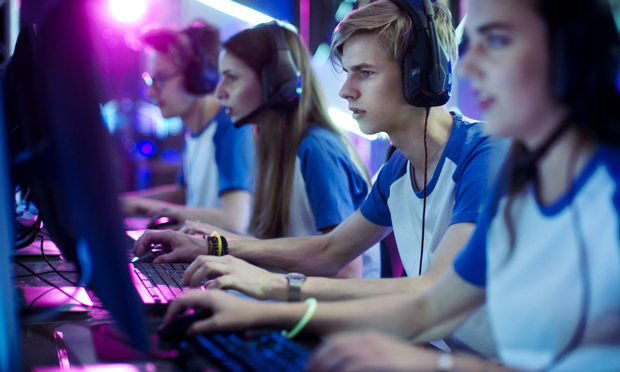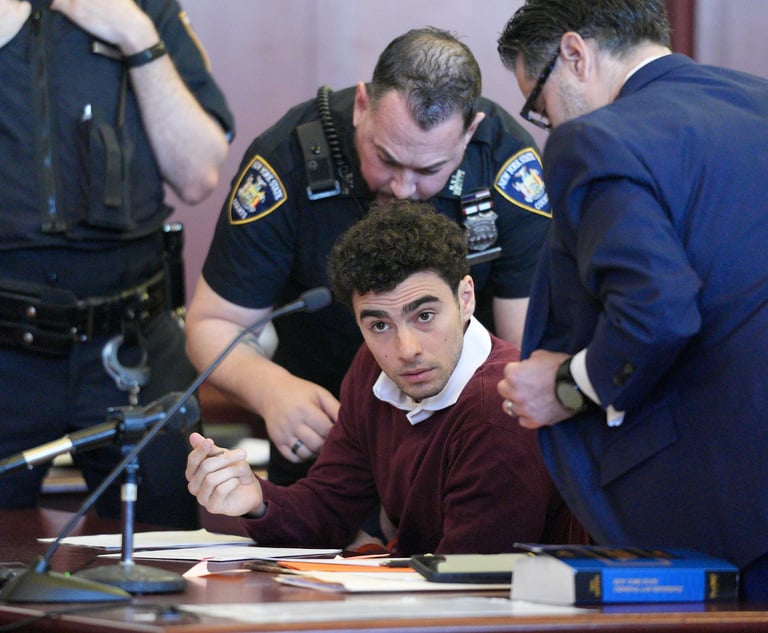The Antitrust Lion at Esports' Door: An Impending Threat
Soon, the competitive video game industry must address its own growing market share—either voluntarily or in the form of lawsuits and regulations imposed from the outside.
May 09, 2019 at 01:27 PM
6 minute read
 Team of Professional eSport Gamers Playing in Competitive Video Games on a Cyber Games Tournament.
Team of Professional eSport Gamers Playing in Competitive Video Games on a Cyber Games Tournament.
Esports—competitive video gaming, particularly involving professional leagues, teams and players—potentially faces an impending, although largely unexpected, crisis.
As esports continues its meteoric growth, its antitrust exposure also grows. Protecting competitive free markets has shaped industries ranging from aviation to energy to communications. Soon, the competitive video game industry must address its own growing market share—either voluntarily or in the form of lawsuits and regulations imposed from the outside. Identifying and implementing proactive policies and carefully charting how to operate effectively within antitrust regulations is paramount to continuing esports' success.
Esports has grown largely by following the traditional sports' playbook, including the creation of video game specific leagues, franchise teams and professional players. Like traditional sports, in addition to professional teams and players, esports' success has resulted in the rise of high school and collegiate esports, and esports is increasingly becoming a viable career, one in which players often specialize in a not just a single genre, but a single game.
Unlike traditional sports, however, esports faces an inherent and fundamental antitrust concern rooted in the fact that video game publishers enjoy intellectual property protections over almost all aspects of their games. These intellectual property rights allow the game publishers to control, and change, basic issues including who can play, how they can play, and how viewers watch. The command over the games provides an unparalleled ability to dictate almost all aspects of competitive video gaming.
The greater control game publishers exert over the leagues and tournaments, streamers, content creators and other esports participants, the harder it becomes for those not affiliated with the game publishers to participate in the affiliated markets, potentially offering competing games, content, tournaments or teams. Publisher-dominant leagues could therefore raise concerns of claims of reduced competition. Awareness of the antitrust laws and proper planning offers the most logical and accessible strategy for addressing competitive concerns without drastically altering the framework that has led to the success of esports or otherwise stifling the development of future games or leagues.
For example, esports' current control and operational advantages could be points of antitrust concern. The degree to which a game publisher controls access to its intellectual property may create barriers to entry, which might limit entrants by competitors at various levels of the market. Further, teams and players operate under agreements with, or at the discretion of, the game publishers and may have little recourse if their agreements are terminated for violating rules, user license terms, or user agreements.
As per the terms of many of the current licenses in the market, game publishers have the power to ban, and already have banned, players and their teams from playing and competing in their games for conduct the players engaged in sometimes years ago—often before they joined the team now being banned. The team owners, who have usually invested thousands or millions of dollars in their teams, have little recourse beyond requesting that the game publisher who issued the ban reconsider. Game publishers similarly control who can broadcast and distribute tournaments involving their games and how and where they can be broadcast and distributed.
In the context of traditional “stick and ball” sports, the United States Supreme Court has held that the relevant market for antitrust analysis can be as discrete as a single sport, and that an entity that controls the broadcast of that sport has sufficient market power to support antitrust violations under certain circumstances. For this reason, among others, leagues have obtained limited scope antitrust exemptions to address specific antitrust concerns, and otherwise creatively structured their businesses within the scope of the antitrust laws. A similar analysis may very well apply to game publishers, who have control over their games, their broadcast and distribution, and the ancillary content flowing from the games. Rather than treating esports as a collective, antitrust plaintiffs and regulators will likely assert that the game publishers' control over each game establishes a sufficiently definite and dominant antitrust market for each individual game.
Faced with lawsuits and potential regulations, game publishers will likely respond by arguing that their actions fall within the scope of their legitimate rights to manage and control their intellectual property. The success of these yet-untested arguments is far from certain. In each instance, the antitrust analysis will focus on whether the scope of the intellectual property protection is sufficiently strong so as to protect behavior through the entire market. Stated differently, are the intellectual property rights so pervasive that it affords the game publisher control of every aspect of the game it produces downstream, from tournaments, to streaming content, to other traditional “fair use” avenues? This question, unfortunately, is largely subject to fact-intensive inquiries and legislation.
Structures have consequences. As a result, the impact of those structures must be evaluated to ensure that the risk from any suits or inquiries can withstand antitrust scrutiny. If game publishers overreach, limiting competition to the detriment of the participants and fans, the publishers could face antitrust suits challenging their actions or new regulations by governmental agencies that do not participate in the market but, nonetheless, wish to control how it operates.
Those in the esports ecosystem will be well-served to evaluate their antitrust exposure and proactively implement creative solutions to avoid, or at least mitigate, their risks—particularly those that would relax intellectual property protections. Self-governance, guided by existing antitrust law, can protect existing esports interests while promoting competition without unnecessarily eroding existing intellectual property protections, and the antitrust laws provide latitude to develop varying solutions for each game and league.
Failure to act, or at least understand how antitrust laws may impact the esports market, could result in the imposition of broad, third-party “solutions” that are poorly tailored to the industry's diverse constituents, games, and needs. As with any exposure, whether from litigation or regulation, preemptively working to craft the solutions mitigates risks, allows for more control, and results in a framework that can facilitate, rather than impair. Esports is growing and will continue to grow. Accordingly, it must consider and address how the antitrust laws apply to this new, burgeoning market.
William Stark ([email protected]) and Steve Walkowiak ([email protected]) are shareholders at Greenberg Traurig and co-chairs of the firm's Video Games and Esports practice group. Katie Tipper-McWhorter ([email protected]) is an associate at Greenberg Traurig.
This content has been archived. It is available through our partners, LexisNexis® and Bloomberg Law.
To view this content, please continue to their sites.
Not a Lexis Subscriber?
Subscribe Now
Not a Bloomberg Law Subscriber?
Subscribe Now
NOT FOR REPRINT
© 2025 ALM Global, LLC, All Rights Reserved. Request academic re-use from www.copyright.com. All other uses, submit a request to [email protected]. For more information visit Asset & Logo Licensing.
You Might Like
View All

Nondisparagement Clauses in Divorce: Balancing Family Harmony and Free Speech
6 minute read

Trending Stories
- 1Reviewing Judge Merchan's Unconditional Discharge
- 2With New Civil Jury Selection Rule, Litigants Should Carefully Weigh Waiver Risks
- 3Young Lawyers Become Old(er) Lawyers
- 4Caught In the In Between: A Legal Roadmap for the Sandwich Generation
- 5Top 10 Developments, Lessons, and Reminders of 2024
Who Got The Work
J. Brugh Lower of Gibbons has entered an appearance for industrial equipment supplier Devco Corporation in a pending trademark infringement lawsuit. The suit, accusing the defendant of selling knock-off Graco products, was filed Dec. 18 in New Jersey District Court by Rivkin Radler on behalf of Graco Inc. and Graco Minnesota. The case, assigned to U.S. District Judge Zahid N. Quraishi, is 3:24-cv-11294, Graco Inc. et al v. Devco Corporation.
Who Got The Work
Rebecca Maller-Stein and Kent A. Yalowitz of Arnold & Porter Kaye Scholer have entered their appearances for Hanaco Venture Capital and its executives, Lior Prosor and David Frankel, in a pending securities lawsuit. The action, filed on Dec. 24 in New York Southern District Court by Zell, Aron & Co. on behalf of Goldeneye Advisors, accuses the defendants of negligently and fraudulently managing the plaintiff's $1 million investment. The case, assigned to U.S. District Judge Vernon S. Broderick, is 1:24-cv-09918, Goldeneye Advisors, LLC v. Hanaco Venture Capital, Ltd. et al.
Who Got The Work
Attorneys from A&O Shearman has stepped in as defense counsel for Toronto-Dominion Bank and other defendants in a pending securities class action. The suit, filed Dec. 11 in New York Southern District Court by Bleichmar Fonti & Auld, accuses the defendants of concealing the bank's 'pervasive' deficiencies in regards to its compliance with the Bank Secrecy Act and the quality of its anti-money laundering controls. The case, assigned to U.S. District Judge Arun Subramanian, is 1:24-cv-09445, Gonzalez v. The Toronto-Dominion Bank et al.
Who Got The Work
Crown Castle International, a Pennsylvania company providing shared communications infrastructure, has turned to Luke D. Wolf of Gordon Rees Scully Mansukhani to fend off a pending breach-of-contract lawsuit. The court action, filed Nov. 25 in Michigan Eastern District Court by Hooper Hathaway PC on behalf of The Town Residences LLC, accuses Crown Castle of failing to transfer approximately $30,000 in utility payments from T-Mobile in breach of a roof-top lease and assignment agreement. The case, assigned to U.S. District Judge Susan K. Declercq, is 2:24-cv-13131, The Town Residences LLC v. T-Mobile US, Inc. et al.
Who Got The Work
Wilfred P. Coronato and Daniel M. Schwartz of McCarter & English have stepped in as defense counsel to Electrolux Home Products Inc. in a pending product liability lawsuit. The court action, filed Nov. 26 in New York Eastern District Court by Poulos Lopiccolo PC and Nagel Rice LLP on behalf of David Stern, alleges that the defendant's refrigerators’ drawers and shelving repeatedly break and fall apart within months after purchase. The case, assigned to U.S. District Judge Joan M. Azrack, is 2:24-cv-08204, Stern v. Electrolux Home Products, Inc.
Featured Firms
Law Offices of Gary Martin Hays & Associates, P.C.
(470) 294-1674
Law Offices of Mark E. Salomone
(857) 444-6468
Smith & Hassler
(713) 739-1250






